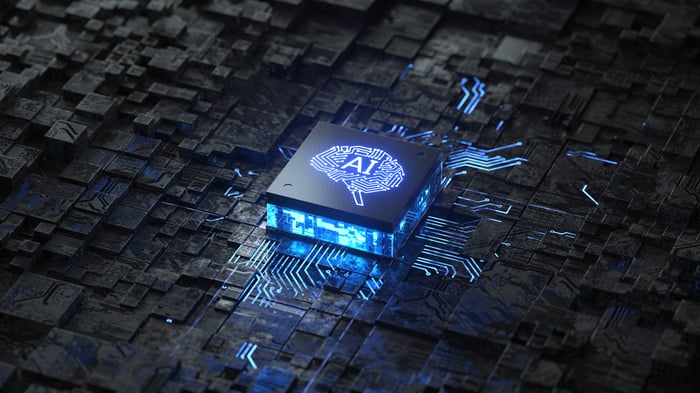Cathie Wood is one of the most vocal technology bulls on Wall Street. She's the head of Ark Investment Management, which manages eight exchange-traded funds (ETFs) focused on different segments of the tech sector. The firm has issued some incredibly optimistic forecasts, specifically regarding the potential of artificial intelligence (AI).
Ark believes AI could add a staggering $200 trillion in output to the global workforce by 2030, thanks to its ability to speed up everything from computer programming to medical discoveries. So far, semiconductor giant Nvidia (NVDA 3.08%) has been the greatest financial beneficiary of the shift to AI because it produces the most advanced data center chips in the world designed for AI workloads.
But hardware is only one half of the equation. In an interview with Bloomberg TV earlier this year, Cathie Wood said the next big AI opportunity for investors might be in software instead.
She thinks for every $1 in chip hardware Nvidia sells, software companies will generate $8 in revenue because they will help businesses operate at a scale never before possible. That could amount to a $14 trillion revenue opportunity in the AI software space by the end of this decade, according to Ark.
I'll share two stocks investors will be thankful they bought today if Wood's prediction comes to fruition.

Image source: Getty Images.
1. Nvidia: Surprise! It's more than just a semiconductor giant
Most investors know Nvidia for its advanced graphics chips (GPUs), which have become the hardware of choice for developing, training, and deploying artificial intelligence applications. The company's CEO, Jensen Huang, says there is $1 trillion worth of existing data center infrastructure that needs to be upgraded to support accelerated computing and AI. Nvidia's market share is estimated to be 90% in the latter segment, so it's facing a gigantic financial opportunity.
But Nvidia is also a software company with a portfolio of successful products. Developers use its CUDA (Compute Unified Device Architecture) platform to build applications on top of the company's GPU chips. It can accelerate tasks like training AI models, and it can't be ported across to other hardware platforms built by competitors like Advanced Micro Devices.
That's why it's so difficult to unseat Nvidia's dominance right now; leading developers are already familiar with CUDA, so switching to a different chip provider means they'd have to abandon the software, too.
Nvidia has also developed a platform called Drive. It's an end-to-end hardware and software solution for car manufacturers looking to install fully autonomous self-driving capabilities in their vehicles. It has already attracted top brands like Mercedes-Benz and electric vehicle company Nio. Its revenue pipeline is worth a whopping $14 billion already, which will be realized between 2023 and 2028.
Nvidia is coming off two blockbuster quarterly earnings reports, which rank among the most impressive in U.S. corporate history. In May, with the release of its fiscal 2024 first quarter results, the company issued an $11 billion second-quarter revenue forecast, which was almost $4 billion above Wall Street's estimates.
But when the second quarter (ended July 30) rolled around, it ended up generating a whopping $13.5 billion instead, marking a 101% increase year over year. It was driven by demand for AI chips in its data center segment. But it gets even better; Nvidia issued a monster $16 billion revenue forecast for the current quarter.
These results are the primary reason Nvidia stock has more than tripled in 2023 so far, but given its combined multitrillion-dollar AI hardware and software opportunities, this might only be the start of a long-term growth story.
2. Palo Alto Networks: This might be cybersecurity's leading AI company
Cloud computing is the technology companies use to operate online and power their digital sales channels. Therefore, most AI development happens in the cloud via centralized data centers, because that's where companies store mountains of their most valuable information. While that digital infrastructure offers significant benefits, it's also exposed to cyberthreats around the clock, and Palo Alto Networks (PANW 2.56%) is on a mission to deliver the most advanced cybersecurity software.
In 2021, it would take 44 days for a cyberattacker to breach a company's network and steal its data. That time frame shrank to 30 days in 2022. But now, it can happen in a matter of hours. Palo Alto says 93% of security operations centers still rely on human-led processes, but there is no way that system can keep up with the speed of modern-day threats. As a result, an estimated 23% of security alerts are ignored and never investigated.
To solve that critical problem, Palo Alto is embedding AI across its product portfolio to help businesses automate incident detection and response. So far, AI is powering 35 of its cybersecurity software tools across the three main business categories: cloud security, network security, and security operations. Plus, the company is innovating at the fastest pace in its history, releasing an all-time high 74 new products overall during fiscal 2023 (ended July 31).
Palo Alto says it has installed sensors with 48,000 customers, which collect 4.8 petabytes (4,800 terabytes) of data every day. That information is used to train its AI, including new generative AI tools customers can interact with to rapidly learn about incidents and potential vulnerabilities. This has the ability to significantly reduce the workload on security operations teams.
Palo Alto generated $6.8 billion in revenue during fiscal 2023, a figure which has more than tripled in the last five years. It also had $10.6 billion in remaining performance obligations, up 30% compared to fiscal 2022. That figure is a representation of how much revenue the company might generate a few years from now.
Palo Alto stock is trading near an all-time high right now, but there will likely be plenty of upsides in the cards over the long term, especially as it continues to expand its portfolio of AI-powered cybersecurity tools.





